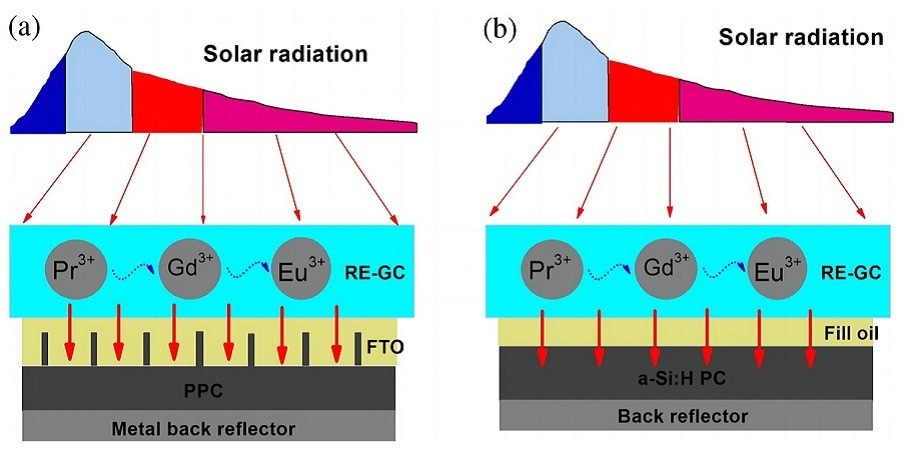Photovoltaic cells (PCs) have attracted a lot of attention globally as promising renewable energy sources during the last 10 years. PCs still cannot achieve high enough light-to-electricity conversion efficiencies to be widely used, so researchers are always searching for new, more effective materials and designs.
 Applying a transparent Pr3+/Eu3+-doped glass-ceramic layer on top of a photovoltaic cell simultaneously protects it from damaging UV light and converts that UV radiation to visible light, thereby enhancing the light-to-energy conversion efficiency. Image Credit: Journal of Photonics for Energy.
Applying a transparent Pr3+/Eu3+-doped glass-ceramic layer on top of a photovoltaic cell simultaneously protects it from damaging UV light and converts that UV radiation to visible light, thereby enhancing the light-to-energy conversion efficiency. Image Credit: Journal of Photonics for Energy.
Perovskite and amorphous silicon carbide (a-SiC:H) PCs are two of the most researched PC types. Perovskite photovoltaic cells have two main drawbacks. Firstly, their low energy conversion efficiency stems from the fact that they only utilize a small portion of the ultraviolet (UV) light spectrum, which is covered by solar radiation.
Second, exposure to intense UV light can cause photo-degradation in them. On the other hand, because of a mismatch between the spectral response of a-SiC:H materials and the spectral profile of sunlight, a-SiC:H PCs are unable to harvest UV light efficiently.
But what if these issues could be resolved with just the addition of a unique transparent layer to the PC's surface? A research team led by Dr. Pei Song from Shanghai University of Engineering Science, China, created a novel solar spectral converter in a recent study that was published in the Journal of Photonics for Energy.
The team used a GdPO4 glass-ceramic (GC) material that had been doped with praseodymium (Pr) and europium (Eu) ions. Significant improvements in solar cell performance and applicability could result from this technology.
The primary function of GdPO4-GC:Eu3+/Pr3+ is to reemit visible light after absorbing UV photons from solar radiation. The effective energy transfer that takes place between the ions in the material makes this possible.
An excited electronic state is produced in a Pr3+ ion upon interaction with a UV photon. There’s a good chance that this stored energy will be moved to a Gd3+ ion, which will release some of it before moving the remaining portion to an Eu3+ ion. Visible light is released when the excited electronic states of the Eu3+ ion downshift to lower energy states.
The Gd3+ ions serve as bridges between the Pr3+ and Eu3+ ions during these energy transitions, as several experiments have demonstrated. Therefore, a thin transparent layer of GdPO4-GC:Eu3+/Pr3+ applied to a PC provides it with extra light in addition to shielding it from UV photons.
Furthermore, in perovskite solar cells, this shielding action aids in preventing photo-degradation. Meanwhile, by making the system “sensitive” to UV photons that would otherwise be wasted, the spectral conversion layer in perovskite and a-SiC:H PCs aids in the system’s overall efficiency in using energy from solar radiation.
Interestingly, the suggested GdPO4-GC:Eu3+/Pr3+ material can be easily synthesized using a traditional melting and quenching method. Furthermore, the material shows promise as a protective layer for space-borne PCs, like those found in space stations, because it is also remarkably stable.
Nowadays, expanding space stations require more power support and need high-performance PCs. By covering the top side of a PC with the proposed spectral conversion material and using appropriate encapsulation and sealing technology, we can ensure very low humidity levels and efficient UV recycling. In addition, GC materials have a hard texture, so they can protect PCs from being hit by tiny floating debris in space.
Pei Song, Researcher, SPIE
To increase the effectiveness of PCs employing doped GC materials as spectral converters, more research will be required. Future research, according to the researchers, might concentrate on enhancing cost-effectiveness through modifying doping concentrations and maximizing the protective layer’s thickness.
With potential applications in both terrestrial and space PCs, the development of spectral downshifting Pr3+/Eu3+ co-doped glass-ceramics might open up new avenues to achieve better performance in photovoltaic devices.
Pei Song, Researcher, SPIE
There is hope that solar energy will not just emerge as the energy source of the future but also stand as an environmentally conscious replacement for fossil fuels!
Journal Reference:
Song, P., et al. (2023). Ultraviolet-wavelength driven solar spectral converter for photovoltaic cell application. SPIE. doi.org/10.1117/1.JPE.14.015501.